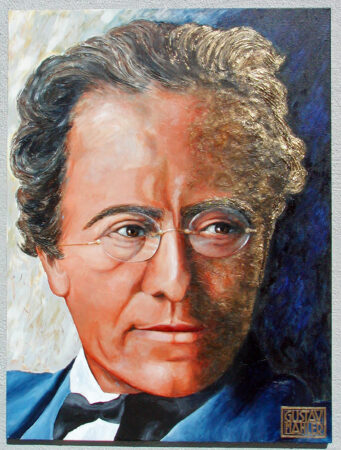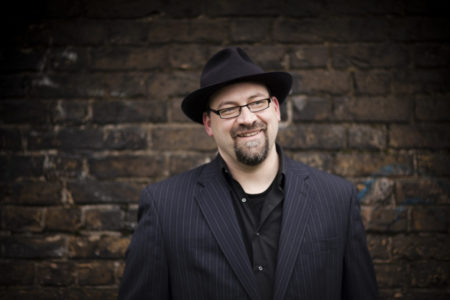
OLYMPUS DIGITAL CAMERA
Gustav Mahler’s road to professional and artistic success was not an easy one. He had spent nearly 20 years rising through the ranks as a conductor, first in tiny provincial opera houses and later in major metropolitan centers like Hamburg and Budapest. Finally, in 1897, he took up the most prestigious conducting position in Europe as General Director of the Vienna Court Opera. By the beginning of the 20th century, he was one of the best-known and most influential musicians in the world.
Then, on February 24, 1901, disaster struck. Mahler suffered a serious hemorrhage. He had been noticeably unwell during his performance of The Magic Flute at the Court Opera that day, and, by the evening, surgeons were struggling to stop the bleeding and save his life. Once his condition was stabilized, he required two more serious operations to restore his health, and his recuperation took months. It was one of the most dramatic and serious of the many unexpected tragedies and challenges that Mahler experienced throughout his life.
However, Mahler always faced these setbacks with tremendous resolve and resilience. Within just a few months of that brush with death, Mahler had begun work on his Fifth Symphony, one of his most revolutionary and important works. After a decade in which his music had been permeated with the magical folktale world of the Des Knaben Wunderhorn songs and poems, Mahler’s Fifth Symphony stared boldly into the new century. Darker, more abstract, more contrapuntal, more modern in its use of form, it signalled a huge re-imagining of his creative language. In its final form, the Fifth Symphony charts a journey from darkness to light not unlike that of Beethoven’s Fifth, a work with which it is often compared. But where Beethoven’s Fifth ends in the unambiguous triumph of hope over despair, Mahler’s Fifth is more equivocal and more ambivalent. As Mahler began the new century, he seemed to be saying that tragedy and adversity are forever part of the human condition, that there can never be such a thing as “happily ever after,” but that when storms pass, we must embrace life, seize the moment, and celebrate.
For me, this makes Mahler’s Fifth the perfect work with which to celebrate our return to music making after the disruptions, disappointments, and tragedies of the Covid-19 era. The great setbacks that we have lived through—whether personal ones like Mahler’s hemorrhage, or societal ones like the pandemic—remind us of the fragility of life, and of the limitations of our ability to shape our destiny. But they also remind us to celebrate the joy of life and the beauty of the everyday.
Composer Philip Sawyers has become recognized as one of the most important symphonists of the past 50 years. Like somany musicians, Sawyers saw many long-anticipated projects disappear overnight following the emergence of Covid-19. However, like Mahler, he has channelled his energies back into his creative work, and since then he has produced a new Viola Concerto, a Double Concerto for Violin and Cello, a string orchestra piece, and, most recently, his Fifth Symphony.
Whether by coincidence or design, Sawyers’s Fifth is also in five movements, and, like the Mahler, it shows a composer at the height of his powers exploring new musical territory. Sawyers has always had a readily identifiable musical personality, but there is much in this work that hints at new pathways for Sawyers to explore in the years to come. The draft of a Sixth Symphony is already on his desk.
In my programming for Colorado MahlerFest over the past few years, I have been keen to explore both the central role Mahler played in the cultural life of his time, and the profound influence he had on future generations. Our two chamber concerts this year, Mahler’s Contemporaries and Mahler’s Heirs, give us a wonderful chance to see the impact Mahler’s presence and ideas had on several generations of composers, and to explore how the historical events they all lived through shaped them in different ways.
Mahler was only 51 when he died in 1911, just a few years before World War I. With a dose or two of penicillin, he not only might have lived through through World War I but also could have been a major figure in the musical revolutions of the 1920s, which we explore in our Friday night concert. In fact, his contemporary Richard Strauss would survive both world wars. What might Mahler have achieved in the 1930s and 1940s? How might the unspeakable tragedies and crimes of those two wars have affected him? His younger colleagues like Gál and Schulhoff were dragged into military life during World War I, and Schulhoff suffered terrible posttraumatic stress disorder as a result of what he experienced. Worse was, of course, to come, bringing exile for some and extermination for others in the 1930s and 1940s.

Kenneth Woods
Almost as appalling as what this generation endured on a human level is the fate of their music in the years after World War II, when the music of Zemlinsky, Korngold, Gál, Schulhoff, and Kahn was met with little more than disdain, apathy, and derision. Within a generation, this incredible body of work was largely forgotten. I feel passionately that MahlerFest has an important role to play in celebrating this music, which is some of the most engaging and rewarding of the past century and which is an important part of the legacy of Gustav Mahler.

Ken Woods, Artistic Director
